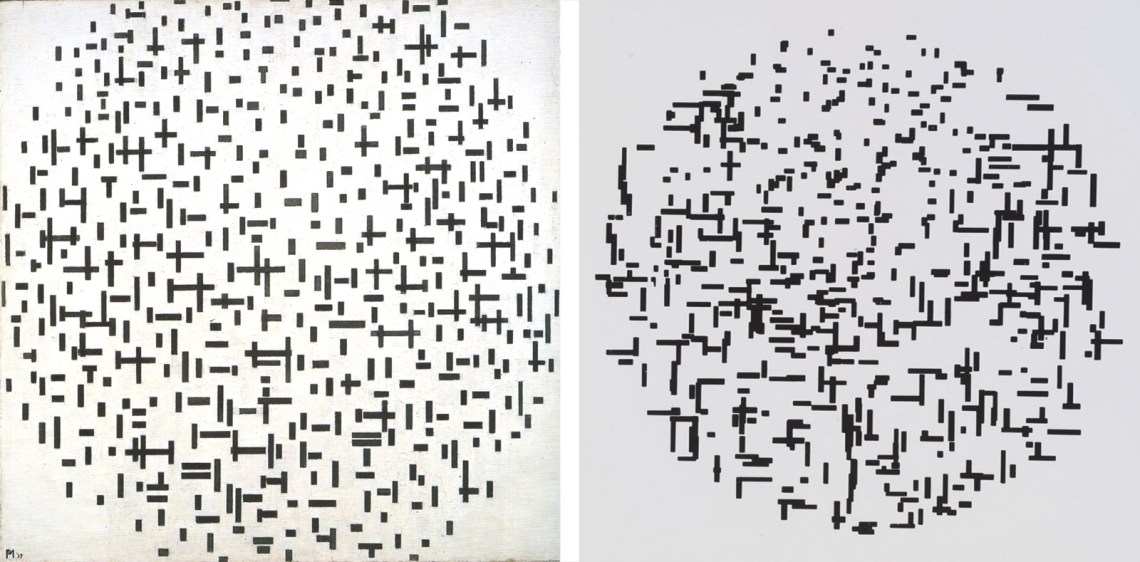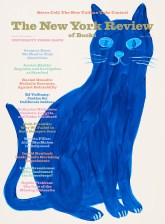In response to:
The Chilliest Mystique from the May 11, 2023 issue
To the Editors:
Jed Perl’s article “The Chilliest Mystique” [NYR, May 11] states, “A. Michael Noll’s and Frieder Nake’s computer-generated variations on works by Mondrian and Klee are just copycat stuff.” The pioneering investigations in the 1960s of the potential for digital computers in the visual arts and experimental aesthetics were far from what Perl characterizes.
In the early 1960s I used programmed randomness along with mathematical order to program a digital computer to produce images—they were called “patterns”—although I considered them abstract computer art. In one experiment, I used a painting by Piet Mondrian to motivate the program, and I then performed experimental psychological comparisons of the Mondrian with the computer version—the computer version was most preferred.1 I also performed research using mathematical variations of the images to determine whether those with artistic training had special artistic preferences—they did not.2 I gave credit to Mondrian, who inspired my investigation of the potential for digital art—this was not “copycat stuff.” To some extent, the Mondrian experiment was a crude Turing test of machine intelligence.
Others (such as Frieder Nake) and I were using digital computers in the 1960s to create examples of how artists might in the future program and use digital computers as a new, creative, artistic medium. My works usually combined programmed randomness with mathematical equations—what today is known as algorithmic computer art. My guess is that artists such as Piet Mondrian and Paul Klee followed rules—algorithms—in creating their artworks. Thus their works inspired some of Nake’s and my algorithmic computer art.
My objective was to educate artists and others about the possibilities of digital computers as a new medium in the visual arts. In one example, I programmed the computer to plot ninety parallel sinusoids with linearly increasing period next to each other—thereby replicating a painting by the op art artist Bridget Riley and showing how easily a digital computer could generate op art.3 Op art was based on visual psychology and used algorithms in its creation.
Is there a bias—or perhaps a fear—against technology and digital computers in the arts? The Los Angeles County Museum of Art (LACMA) show “Coded” (curated by Dr. Leslie Jones) is described in the article as a celebration of “the fascination that some visual artists have had with computers and artificial intelligence since the technology was in its infancy.” A “tangled relationship between people and machines” is claimed.
A fear of computers and artificial intelligence goes way back to the 1950s and 1960s—and more recently extends to the Y2K bug, NFTs, virtual reality, and the metaverse. I would have hoped that by now some critics had gotten over their distrust and fear of new media, new technologies, and new tendencies. The use of digital computers should not be an excuse for “bad” art or an end in itself. The “art”—not the medium—is what should matter.
The earliest use of computers in art goes back to the 1950s and 1960s. The Howard Wise Gallery had a show about computer art in 19654—MoMA then had no interest in this possible new medium. MoMA’s 1968 show “The Machine” mostly ignored the digital machine—the digital computer—and focused on mechanical contraptions. Howard Wise had an open mind to the new. Wise in the 1960s exhibited video art by Nam June Paik. Paik saw the Wise computer art show and as a result came to Bell Labs and learned how to program, and actually programmed his own computer art in the late 1960s. Wise knew that the art world of New York was too conservative and conventional—and Wise educated the public about the possibilities for new media.
Jasia Reichardt curated the show “Cybernetic Serendipity” at the Institute of Contemporary Arts in London in 1968.5 Her show was innovative and explored the possibilities of the new media that she discovered and presented. This was over five decades ago. Reichardt acknowledged that this was a beginning and might ultimately lead to new art.
We need to applaud Jasia Reichardt, Nam June Paik, Howard Wise, and a host of innovators from the 1960s who saw the possibilities for digital computers in the visual arts. Indeed, all this was a beginning that showed the way for the many that followed over the ensuing decades.
A. Michael Noll
Professor Emeritus of Communications
USC Annenberg School
Los Angeles, California
Jed Perl replies:
Readers can judge for themselves whether A. Michael Noll was producing “copycat stuff” in the 1960s. Above are two images, one a 1916–1917 Mondrian, the other a work Noll made with the assistance of a computer in 1964. Does Noll imagine that he’s added anything to the Mondrian?
What Noll’s letter reveals is an inability to distinguish between art and what he refers to as “research.” He seems to imagine that Mondrian and Paul Klee (whose work Frieder Nake subjected to computerized variations in the 1960s) “followed rules—algorithms” in a way not entirely unlike the way an engineer (or an aspiring artist) programs a computer. There’s an undercurrent of philistinism in Noll’s inability to distinguish between art and engineering. He gives himself away as an out-and-out philistine when he proudly explains that when asked to compare “the Mondrian with the computer version—the computer version was most preferred.” Does Noll imagine that by providing a footnote to a paper published in The Psychological Record in 1966 he’s somehow giving legitimacy to what amounts to a downgrading of Mondrian? Noll accuses me of “a bias—or perhaps a fear—against technology and digital computers in the arts.” I think that Noll, perhaps unbeknownst to himself, has a fear of the artistic imagination—the creative act.
Noll believes that the LACMA show, a beautifully produced walk down memory lane, doubles as a guide to the future. He isn’t the only person with a sentimental attachment to the Howard Wise Gallery and Jasia Reichardt’s “Cybernetic Serendipity” show—there can be something consoling about contemplating old-fashioned visions of the future. But the future is here, and nearly everybody who’s familiar with artificial intelligence is concerned about its current and future impact on art, literature, scholarship, science, politics—and society in general. In a recent article, “Why AI Will Never Rival Human Creativity,” William Deresiewicz writes, “We argue whether artificial intelligence is truly intelligent, but even if it is, intelligence and creativity are very different things.” He goes on to speak of “the degraded conception of creativity that has taken hold, in recent years, in tech.” That degraded conception was beginning to take hold more than half a century ago. You see it—at least I see it—in a lot of the work in the LACMA show.
Noll’s letter gives me an opportunity to revisit the predigital origins of what the LACMA show presents as digital modernism. Here are a few facts about Brion Gysin that I discovered only after finishing my article. When I suggested that Gysin’s experiments with word repetitions—some computer-assisted—would have been impossible without the earlier example of Gertrude Stein, I didn’t know that Gysin had met Stein and her partner, Alice B. Toklas, in the 1930s. I only realized this when I happened to pick up Staying on Alone, the volume of letters that Toklas wrote after Stein’s death, which contains several to Gysin. It gets better. The famous recipe for “Hashish Fudge” in the “Recipes from Friends” section of The Alice B. Toklas Cook Book comes from Gysin. So there seems little doubt that Gysin’s I Am That I Am—in the computer-assisted version performed for BBC radio in 1960—owes something to Gertrude Stein and her literary experiments, developed long before the advent of computers.
This Issue
June 22, 2023
Fireball Over Siberia
Who Are the Taliban Now?
Meow!
-
1
A. Michael Noll, “Human or Machine: A Subjective Comparison of Piet Mondrian’s ‘Composition with Lines’ (1917) and a Computer-Generated Picture,” The Psychological Record, Vol. 16 (January 1966). ↩
-
2
A. Michael Noll, “The Effects of Artistic Training on Aesthetic Preferences for Pseudo-Random Computer-Generated Patterns,” The Psychological Record, Vol. 22 (October 1972). ↩
-
3
A. Michael Noll, “Computers and the Visual Arts,” Design and Planning 2: Computers in Design and Communication, edited by Martin Krampen and Peter Seitz (Hastings House, 1967). ↩
-
4
A. Michael Noll, “The Howard Wise Gallery Show Computer-Generated Pictures (1965): A 50th-Anniversary Memoir,” LEONARDO, Vol. 49, No. 3 (June 2016). ↩
-
5
Jasia Reichardt (editor), Cybernetic Serendipity: The Computer and the Arts, Studio International, July 1968. ↩




